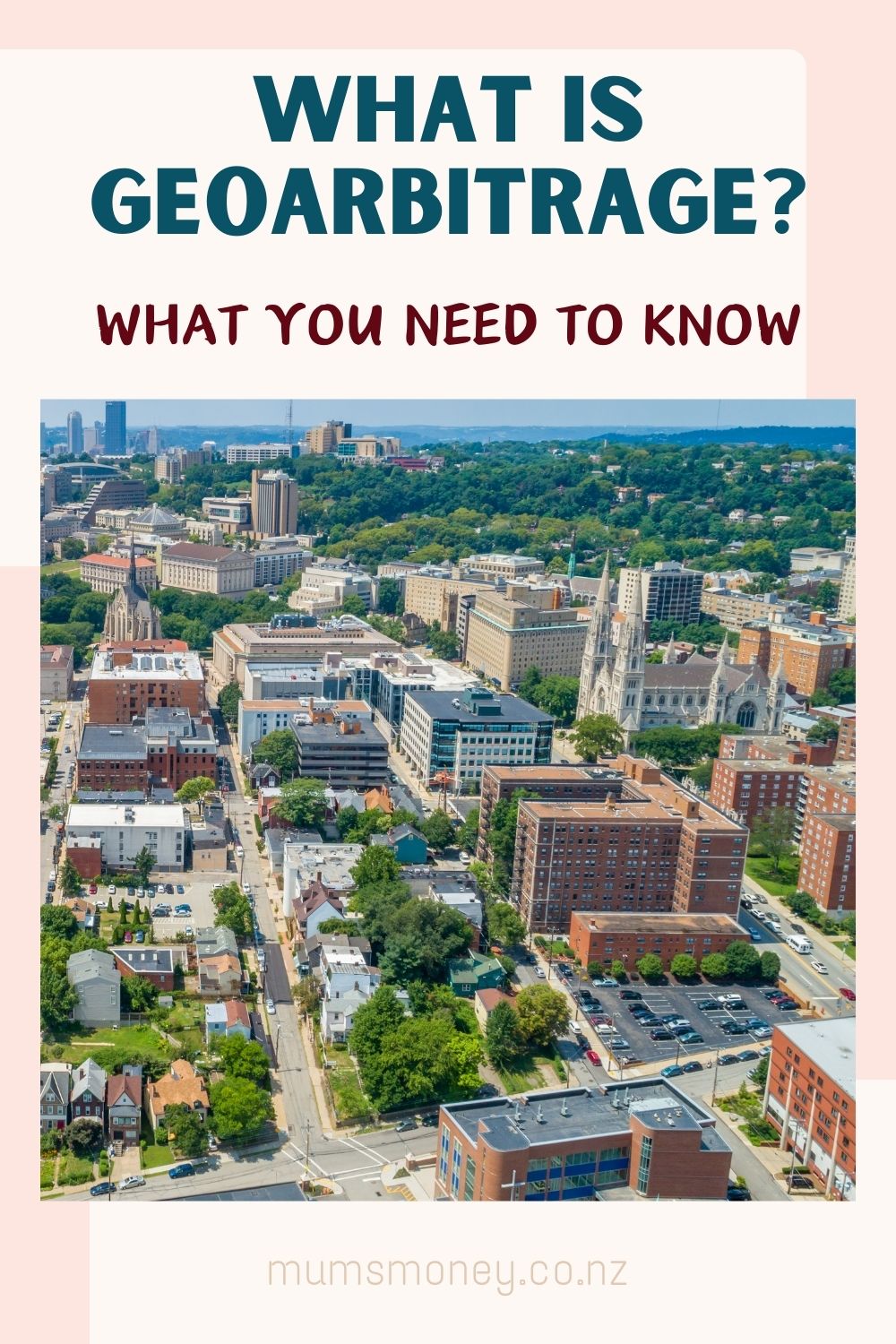Wouldn’t it be wonderful if there was a way to have more money without working more hours, reducing your spending, or taking on more debt?
As it turns out, there is a way to do just that: geoarbitrage. But what is geoarbitrage?
While this term may sound quite technical, the basic premise is actually quite simple.
Geoarbitrage is the act of taking advantage of price differences between two or more geographic areas. You can achieve this by living in a place with a lower cost of living while maintaining your current income, as long as your job is remote.

While this term was coined by Tim Ferris in the popular book, “The Four Hour Work Week,” the idea is not new.
People have been moving to different parts of the world in order to take advantage of different financial opportunities for centuries.
You may be wondering if geoarbitrage is a good option for you, as well as what the potential risks and rewards are.
In this article, we will explore these questions in more detail so that you can make an informed decision about whether geoarbitrage is a good fit for you.
What is Geoarbitrage?
Now that you know the general concept of geoarbitrage, here are some examples to help you understand it a bit better.
If your employer is based in the United States, but you live in Mexico, then this would be an example of geoarbitrage because your cost of living is lower than it would be if you lived in America and worked for that same company.
Another example would be a domestic approach. Say you live in the state of California, and are paying a hefty state tax rate.
You could relocate to a state with no income tax, like Nevada or Texas, in order to keep more of your money and pay less in taxes overall.
An even smaller example is to move from one county to another as a way to lower car registration and property taxes.
This is a big reason why people choose to leave major cities and save a significant amount of money by living on the outskirts.
In addition to moving locations as a way to decrease expenses, many people move to new locations as a way to lower their working hours.
In this day and age, many people work two, three, or more jobs simultaneously to break even, let alone save for emergencies, retirement, and other major life expenses.
This makes geoarbitrage an attractive option for those who want to limit their workweek hours to 40 or less.
So what exactly constitutes a difference in prices?

Generally speaking, there are three main factors that drive price differences: cost of living, wages, and taxes.
The cost of living is made up of things like rent, groceries, transportation costs, and utilities.
It can also include health insurance, car insurance, and educational expenses. If you have children, you’ll also see differences in childcare costs.
Wages are the amount of money people earn for working a certain number of hours or projects.
Places with lower costs of living will often have lower wages, which is why geoarbitrage works best when you relocate while already having a high-earning income source.
Taxes are what governments charge residents in order to fund various public services.
While we all have the same federal tax laws in the United States, there are different tax laws depending on the county or state you reside in.
These differences can be quite substantial, especially for small business owners.
These three financial factors are the main focus when it comes to relocating for a boost to your lifestyle.
Some people prioritize one factor, while others look for all three to maximize their savings.
Benefits of Geoarbitrage
There are many pluses when it comes to embracing this lifestyle, including:
- Lower expenses overall on things like rent and utilities, which means greater cash flow for other investments and savings goals.
- A change of scenery for those looking to try a new region.
- A chance to go on a travel adventure for those who want to slowly see the world.
- Fewer working hours overall, because you can make more money in a shorter time
Disadvantages of Geoarbitrage

Although this method is beneficial for some, it may not be the right cup of tea for others. Here are a few reasons why you may want to avoid this lifestyle:
- You have to uproot your entire life, which can be a hassle when you’re busy with work and family.
- It’s near impossible to live like this if you’re not already earning a significant income online or own a business that allows for remote work.
- Not everyone is cut out for being away from their closest friends and family members.
- Depending on where you relocate, there may be fewer amenities overall, such as limited access to delivery services, entertainment, and health care.
In order to decide whether or not this lifestyle is right for you, ask yourself the following questions:
- What kind of work do I have right now that gives me access to high-paying clients or projects?
- Do I want a change of scenery?
- Am I happy with where I live currently and how much it costs me in terms of expenses, wages and taxes?
- Am I willing to pay moving fees, and possibly downsize my home?
- How do I feel about not seeing my family often or spending time with them in person? Will it be worth it for me if they visit me at my new place of residence once per year or every few years?
- Can I see myself living in different surroundings for an extended period of time?
If you answer yes to most or all of these questions, geoarbitrage may be a great option for you. But if the thought of uprooting your life and making big changes scares you, it may be best to steer clear.
How to Start Geoarbitraging

Here are some tips to help you get started if you decide this lifestyle is a good fit for you:
Build Up Your Savings
Before you can start geoarbitraging, you need to build up a significant amount of savings.
Although you will be making this transition as a way to save money and reduce your expenses, it’s important to prepare for the possibility that things may not turn out as expected.
Especially if you’re going to a new country with a digital nomad visa, you may have to deal with issues such as health care expenses, unexpected delays in getting a visa or permit, and higher costs of living than advertised.
As a result, it’s best if you save up at least six months’ worth of expenses before taking the leap. This way, even if things don’t go according to plan, you have time to figure out another way to bring in income.
Secure Remote Income
In order to start geoarbitraging, you first need an income source that allows for remote work. For most people, this means having a job or business in the digital realm – yes, we mean making money online.
If you don’t currently have one of these setups, it’s time to create a plan that helps you develop an online income.
This could mean anything from freelance writing and social media management to starting your own online course or e-commerce store.
Make sure that your source of income is a consistent one. For example, working as a remote contractor for a company may be more stable than freelance work, which could come and go depending on market demand.
Research Your Options

Once you have an online career in place, the next step is finding a place to relocate that offers significant savings on the cost of living expenses, wages, and taxes.
Do some research on different countries or states that fit your criteria. Consider the following factors:
- Cost of living (rent, utilities, groceries)
- Average wages in that area
- Tax rates for both individuals and businesses
- Availability of visas or permits to live there long-term as a remote worker
- Amenities such as Internet speed, entertainment options, and health care access
Once you have a list of potential destinations, it’s time to start narrowing it down to the most viable options.
For example, if one area you would like to live in is only $50 to $100 cheaper than your current location, is it worth the transition?
Conversely, is it worth it to have significant monthly savings to go live in a place that you don’t feel connected to, seems dangerous, or will make you feel isolated?
Use your findings to create a list of pros and cons for each destination, which will help make the final decision easier.
Take The Leap
Finally, once you have everything in place, it’s time to take the leap! Make sure that you have all your ducks in a row before departing, such as having a secure, remote income source and enough savings to get you through at least six months.
If possible, visit your chosen destination beforehand to make sure that it’s a good fit for you. Once you’re there and settled in, enjoy the savings, and take advantage of the extra free time to pursue new hobbies or activities!
Final Thoughts
Geoarbitraging can be a great way to save money and live a more nomadic lifestyle.
However, it’s important to do your research and make sure that everything is in place before taking the leap. Transitioning to a new country or state can be difficult, so make sure that you’re prepared for any potential bumps in the road.
Keep these steps in mind if you’re considering geoarbitraging. Remember to enjoy the journey, and take advantage of all the new opportunities that come your way as you enter your new location and life!
